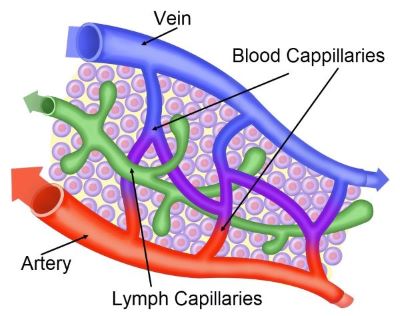Cardiovascular Capillary Transfer
Osmotic/oncotic, and hydrostatic pressures modify blood capillary transfer of nutrients and waste.
Introduction
Three features of water’s chemistry, osmotic pressure, oncotic pressure, and hydrostatic pressure support the primary purpose of the cardiovascular system, capillary transfer into blood of nutrients and transfer out of metabolic waste products like lactic acid.
In this article, I summarize cardiovascular capillary transfer in the three short videos. The first video is a discussion of osmotic pressure and oncotic pressure. Osmotic pressure is often a difficult concept for students when it is first encountered.
The second video deals with hydrostatic pressure as it is defined in physiology for the cardiovascular system. You will notice this definition of hydrostatic pressure is somewhat different than the physics definition.
The third video explains how these three properties of water-based systems work to efficiently transfer material in and out the tissue capillaries.
Osmotic/oncotic pressure influence on capillary transfer
Osmotic pressure is a numerical value that predicts the ability of a watery solution to attract more water molecules. In physiology, watery solutions are frequently separated from each other by a lipid membrane.
Water molecules will move from the side of the lipid membrane with the lowest osmotic pressure to the side with the highest osmotic pressure if there are water channels present.
A high osmotic pressure signifies a solution with a high attraction for water molecules. To discover how osmotic pressure is calculated, view the video by clicking on the image below.
Role of hydrostatic pressure in capillary transfer
To explain capillary exchanges, hydrostatic pressure on blood must also be considered. While osmotic pressure DRAWS water through membrane water channels, hydrostatic pressure FORCES water through them. Check out the video by clicking the image below.
Capillary transfer, filtration and reabsorption
In blood capillary beds, osmotic/oncotic and hydrostatic are opposing pressures. Filtration occurs at the arterial end because hydrostatic pressure is the dominant influence. When hydrostatic pressure drops at the venous end, osmotic/oncotic pressure favors reabsorption of the filtered water. View the video by Clicking on the image below.
Capillary transfer worksheet
Click here for a worksheet that will help you consolidate these concepts which explain blood capillary transfer. Just, a little further investigation of this topic on your own using the worksheet will strengthen your memory of them.
Learning human physiology:
These videos and the worksheet are from Day 21 of my course the 30-Day Challenge: Craft Your Plan for Learning Physiology. To read at the other topics covered over the 30 days of this challenge course click here.
Further Reading:
Water’s Chemistry Governs Physiology
Tips for how to study the cardiovascular system
Do you have questions?
Please put your questions in the comment box or send them to me by email at DrReece@MedicalScienceNavigator.com. I read and reply to all comments and email.
If you find this article helpful share it with your fellow students or send it to your favorite social media site by clicking on one of the buttons below.
Margaret Thompson Reece PhD, physiologist, former Senior Scientist and Laboratory Director at academic medical centers in California, New York and Massachusetts is now Manager at Reece Biomedical Consulting LLC.
She taught physiology for over 30 years to undergraduate and graduate students, at two- and four-year colleges, in the classroom and in the research laboratory. Her books “Physiology: Custom-Designed Chemistry”, “Inside the Closed World of the Brain”, and her online course “30-Day Challenge: Craft Your Plan for Learning Physiology”, and “Busy Student’s Anatomy & Physiology Study Journal” are created for those planning a career in healthcare. More about her books is available at https://www.amazon.com/author/margaretreece. You may contact Dr. Reece at DrReece@MedicalScienceNavigator.com, or on LinkedIn.
Dr. Reece offers a free 30 minute “how-to-get-started” phone conference to students struggling with human anatomy and physiology. Schedule an appointment by email at DrReece@MedicalScienceNavigator.com.






Comments
Cardiovascular Capillary Transfer — No Comments
HTML tags allowed in your comment: <a href="" title=""> <abbr title=""> <acronym title=""> <b> <blockquote cite=""> <cite> <code> <del datetime=""> <em> <i> <q cite=""> <s> <strike> <strong>